Mistakes Home Recordists Make |
|
|
|
|
|
| Feb 24 2017, 04:08 PM |
|
Although it may seem a begginer thing to clean highs and lows, this process can get very technical. My advice to start with cut filters (12 or max 24 db) as shelving may complicate the process for them. Yes. Subtractive EQ as opposed to additive. On so many home recordings there's just a bunch of loud and louder, big and bigger. Also, focusing way too much on getting a great 'solo' or isolated tone on each individual instrument/track rather than on EQing the instrument (or the part) for the track. In other words, not every guitar track needs the Eric Johnson or Joe Satriani tone. Some parts will actually benefit from a thin and what would maybe be considered (by itself) a 'crappy' tone. *That's the main reason I own a few shitty and weird, cheap-o guitars (that play in tune). Many times they are the perfect sound for the track. Here's a good example. There are two 'lead' guitars right at the top. Guitar 1 has this big, beautiful, stringy and very present tone and guitar 2 is thinner, a little cloudy (washed in reverb) and harder to the right in the mix - all giving the impression that it's smaller and farther back ... making it fit perfectly as a musical statement within the whole. *This is also why every guitar player needs a Telecaster. This post has been edited by klasaine: Feb 24 2017, 05:24 PM -------------------- - Ken Lasaine
https://soundcloud.com/klasaine2/foolin-the-clouds https://soundcloud.com/klasaine2/surfin-at-the-country-hop Soundcloud assorted ... https://soundcloud.com/klasaine3 New record ... http://www.cdbaby.com/cd/kenlasaine Solo Guitar ... https://www.youtube.com/playlist?list=PLXZh...5iIdO2tpgtj25Ke Stuff I'm on ... https://www.youtube.com/playlist?list=PLXZh...b-dhb-4B0KgRY-d |
|
|
||
1 User(s) are reading this topic (1 Guests and 0 Anonymous Users)
0 Members:






















